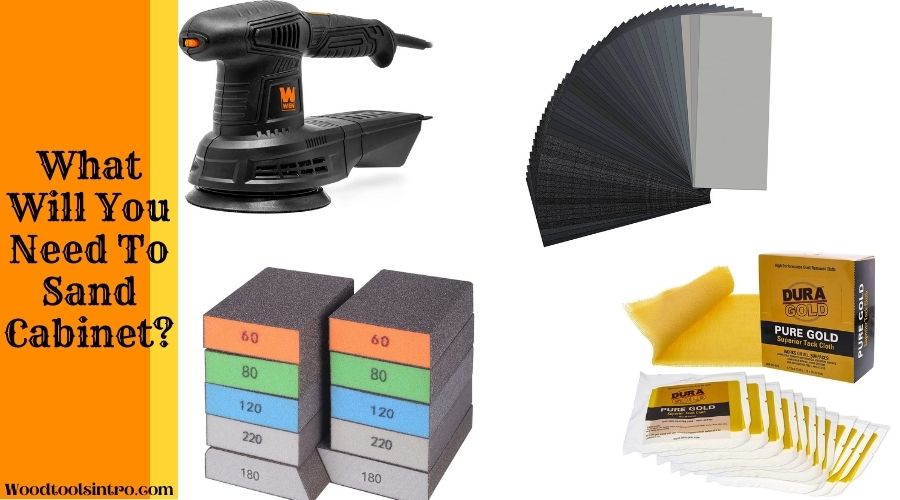Is your cabinet paint chipping or rubbing off? Wondering how to achieve a smooth and glossy finish? One of the primary jobs is sanding the cabinet properly to maximize paint adhesion and prevent chipping down the line. It also reduces water spots and creates an even surface.
But knowing how to sand cabinets is the key. A wrong sanding approach may make the finish uneven or blotchy. It can even damage the wood.
This article will provide detailed guidelines on properly sanding cabinets. Let’s dive in!
What Is The Best Way To Sand Cabinets?
Hand-sanding wood cabinets will be time-consuming. It also requires a lot of physical effort. The best way to sand cabinets is by using an orbital sander.
This hand-held power tool has a random-orbit action to create a smooth and uniform surface with the lowest visible scratches possible.
It will leave surfaces gleaming by stripping away heavy build-ups of varnish or paint from cabinet surfaces.
What Will You Need To Sand Cabinet?

Sanding cabinets are hassle-free when you have all the essential items. Before sanding the wood piece, make sure you have all things nearby.
The followings are the essential supplies you need to sand cabinets.
01. Sander
Choose a compatible and powerful sander to make the polishing task easier. A random orbital sander appears to be a perfect choice for a sanding cabinet.
02. Sandpaper
Select 120, 180, and 220 grit sandpaper for sanding cabinets to remove large amounts of wood and smoothen surface finishes.
03. Sanding Block
Sanding Blocks are necessary to hold sandpaper in place. It is essential for hand sanding to cover any hard-to-reach areas, such as nooks, corners, grooves, etc.
04. Vacuum
Use a special vacuum to trap airborne dust produced in a sanding application and remove more than 90% of the dust from the working area.
05. Tack Cloth
A tack rag comes in handy to remove the majority of the sanding dust and loss particles after the sanding application. It can attract dust quickly due to its stickiness.
06. Coverings
If your working area has valuable items, such as countertops, furniture, or others, it is best to use drop cloths. The covering will protect them from sanding dust and paint splatters.
What Types Of Safety Equipment Will You Need To Sand the Cabinet?

01. Eyewear
Protecting your eyes from a fine spray of wood particles requires wearing goggles. Otherwise, you may experience eye irritation.
02. Hearing Protection
Sanding cabinets with a power tool will generate approximately 95 dB(A). Wear ear protection to protect your inner ear from higher noise levels.
03. Respiratory Protection
Be sure to use respiratory protection to save yourself from inhaling hazardous wood and dust particles.
04. Gloves
Wearing a pair of good-quality gloves will keep your hands safe from dirt. Also, you will feel less vibration in your hands during the sanding.
What Sandpaper Should I Use For Cabinets?
Garnet sandpaper is the best choice for sanding cabinets. It can help you achieve a smoother surface. You can use it for fine sanding and polishing the wood pieces.
This type of sandpaper has natural abrasive properties to remove light scratches and prepare the surface for sanding.
Sanding cabinets don’t require coarse and medium-grain sandpaper. Instead, you need fine grain (120) and very fine grain (180 & 220) sandpaper.
How To Sand Cabinets Step-by-step?
Achieving a tip-top paint finish on a cabinet requires sanding it perfectly. Here is a step-by-step guideline for sand cabinets.
Step: 01—Taking Apart The Cabinets
The first job is disassembling the cabinets. It will give you better accessibility in all areas, including the backs, sides, and interior.
However, be cautious about how you take apart each part. You can make a video and mark each item. This will help you remember each step carefully and make the assembling easier.
Step: 02—Removing Old Paint
Does your cabinet already have a lot of old paint? You can use a paint stripper to strip off the paint surface, remove irregularities, and make the surface smoother.
Let the product sit for 10 to 15 minutes. Then use a paint scraper or filling knife to get off the thick layer of paint.
Paint removers are also suitable for removing varnish, enamel or glue from the cabinet surface.
However, if the cabinets are newly made, use a good-quality degreaser to remove grease, oils, dirt, and grime from the wood surface.
It will also improve the adhesion of the paint and ensure an even finish.
Step: 03—Using Grain Fillers In Pores
Does your cabinet have some pores or holes? Achieving a smooth and clear finish will be challenging unless you fill up these pores and grid patterns.
You can use grain filler or paste wood filler to fill these pores and create a high-standard smooth-textured wood finish.
It will create a more uniform and consistent surface and improve the adhesion of the stain. You are less likely to see uneven and blotchy colors.
Step: 04—Sanding The Cabinets
The next task is sanding the cabinets appropriately. Start with a fine-grit sandpaper, such as 120-grit, to quickly remove a thin layer of wood from the wood surface.
This is handy, especially for maple and oak wood to remove small imperfections and smooth surfaces. It also removes roughness or unevenness on the wood surface.
Next, use 180-grit sandpaper to get off light scratches and scuffs left by 120-grit sandpaper.
Finally, finish the sanding task with 220-grit sandpaper to make the wood surface ultra-smooth and give it a professional-looking finish.
It will help you prepare the cabinets for staining, painting, buffing, and polishing.
Step: 05—Cleaning Off The Wood Surface
After sanding the cabinets properly, use a vacuum cleaner to clean sawdust and other particles.
Wipe the surface using a tack cloth to make the cabinet look neat and clean.
Change the cloth if it no longer picks up enough dust and debris.
Now, your cabinets are reading for painting. Make sure to assemble them correctly once the painting task is completed.
What To Focus on When Sand Cabinets?
Cabinets have several nooks and crannies. It is not easy to sand them using the power tool.
Instead, you want to use a sanding block along with small pieces of sandpaper to sand these hard-to-reach areas.
Make sure to follow the direction of the wood grain to sand the cabinets. It helps minimize visible scratches and achieve a much nicer finish much faster.
Sanding Cabinets Common Mistakes & How to Avoid Them
01. Insufficient or poor sanding will prevent you from achieving a finer finish. Make sure to sand the cabinets perfectly by using different grits of sandpaper.
02. Using different sanding techniques may result in noticeable sanding flaws. Maintain a consistent sanding approach to avoid unevenness.
03. Not cleaning the wood surface between sanding will disallow you to see everything clearly. You may over-sand or under-sand the cabinets.
04. Applying too much using power sanders may damage the wood surface. Use light pressure and keep the sander moving to avoid creating gouges or dips in the wood.
Related Article
Tips & Tricks Sanding Cabinets
01. Whenever you change to new grit sandpaper, clean the wood surface properly. It will help you see the current condition of the piece of the cabinet.
02. Use sanding pads to sand difficult-to-access spots, such as corners, nooks, etc.
03. If your sanding cabinets have too much dirt and dust, clean them with a degreaser or a solution of warm water and mild soap.
04. Don’t forget to sand the inside of the cabinets to a consistent finish throughout the entire cabinet.
Frequently Asked Questions
It allows you to smooth the wood surface, lets the fresh paint adhere well, and prevents premature chipping-off issues.
Dry sanding involves using a manual and mechanical sander to remove rough materials from surfaces without any moisture.
The paint or stain will not adhere well on the surface and will peel or chip off faster.
Final Words
Are you still wondering how to sand cabinets? Sanding these wood pieces is simple if you know the correct method.
Make sure to sand the surface cautiously to avoid damaging it. Don’t forget to change the sandpaper if it is not removing enough materials.

I am Imtiaj Islam. I am a wood working enthusiast, having 6 years of experience in carpentry work. I have a BBA graduate degree from Chittagong College. I got vocational training on wood works from Korean Polytechnic out of the quest and zest he has for carpentry as well. I take several wood projects and keep testing different woodworking tools for comfortable and perfect work. I just love playing with woods and machines.
